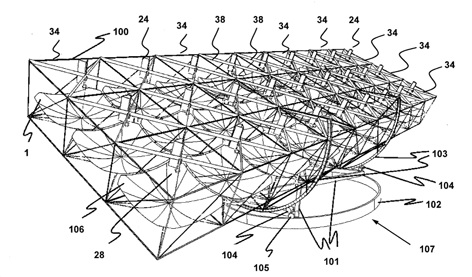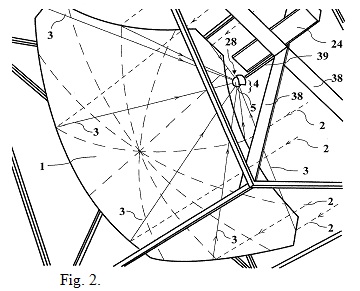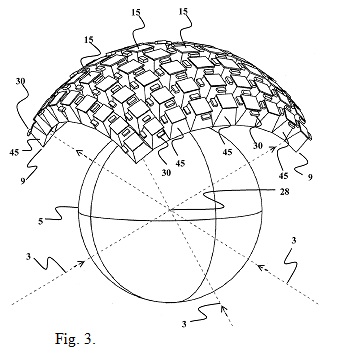REhnu (pronounced “renew”) is a company based in Tucson, Arizona that makes and sells concentrated photovoltaic (CPV) solar energy systems.
The company believes that the greatest energy for the least cost may consist in first greatly concentrating solar energy (1200x), and then converting it to electricity utilizing highly efficient triple-junction photovoltaic cells.

The company’s technology is described in at least three pending patent applications: U.S. Patent Application Publication Nos. 2009/0277440 (‘440 Application), 2009/0277498 (‘498 Application), and 2009/0277224 (‘224 Application). Rehnu CEO and University of Arizona astronomy professor Dr. Roger P. Angel is a named inventor on each of the applications.
A solar tracker “module” has eight large dish reflectors (1) and 36-cell receivers pointed at the sun by a stiff, lightweight frame. Each of REhnu’s reflectors (1) is made from a single, back-silvered glass sheet, 3.1m per side.
The glass is produced in the factory as flat sheets, 3.3 m square according to processes described in the ’224 Application, allowing for use of economical float glass.

Fig. 1. Full-size two-axis solar tracker module disclosed in the ‘440 Application, entitled “Solar concentrator apparatus with large, multiple co-axial dish reflectors”. The reflectors are manufactured via a process disclosed in the ‘224 Application, entitled “Method of manufacturing large dish reflectors for solar concentrator apparatus”.
Then, each sheet is heated and molded into a paraboloid. After cooling, a reflective film of silver is applied to the back surface, like in ordinary mirrors. With rolled edges for stiffening, the resulting finished product is 3.1m x 3.1m.
Next comes the concentration. Each of the eight dishes reflects light into its own ball lens (5), suspended at the focus. Each ball lens (5) concentrates the light (3) 400x before passing it on, evenly, to a concave array of 36 optical funnels (45).

Each optical funnel further concentrates the light (3) to 1200x while funneling the solar energy to its own triple-junction photovoltaic cell (15).

Triple-junction cells, unlike single-junction cells, have three different junctions, each of which separately captures solar energy at distinct wavelengths. This results in more than a doubling of conversion efficiency over single-junction cells, such as silicon.
Triple-junction cells are more costly than silicon cells but cost less per unit power generated when used with highly concentrated light.
According to REhnu’s receivers & cooling web page, “when sold in the quantity needed to generate several megawatts, the cost is projected to soon reach $5/cm2, which at 1200x concentration and 30% module conversion efficiency, works out to $0.16/watt.”
This is roughly one-sixth of the cost per unit of power conversion compared to a single-junction photovoltaic cell used without concentration.
The power produced by triple-junction cells is reduced by 1.35% for every 10°C rise in temperature, though, so cooling is very important. REhnu’s cells are cooled by liquid from a radiator and the radiator is cooled by fans.
Can concentrated solar energy from a ball lens coupled with increasingly efficient energy conversion from triple-junction photovoltaic cells produce cheap electricity from a small footprint on a commercial scale?
According to Rehnu’s web site, the University of Arizona has proven the technology in an 8-cell system, and larger systems continue to be tested to provide the answer to that question.
Article by Jonah Smith, President of the Notre Dame Intellectual Property Law Society and a J.D. candidate at Notre Dame Law School. Jonah is a contributor to the IP Lawyer Blog.

 Follow
Follow